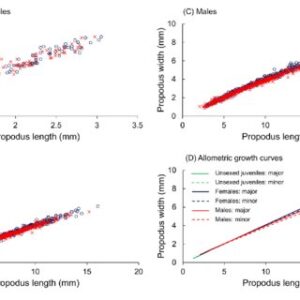Allometric growth
allometric growth is the variation in the relative rates of growth of various parts of the body, which helps shape the organism. In other words, it is the pattern of growth whereby different parts of the body grow at different rates with respect to each other.
Allometry is the study of relative growth and of changes in proportion with increase in size. For example, human arms and legs grow at a faster rate than the body and head. Making adult proportions strikingly different from those of infants.
Another striking example is the male fiddler crab Uca pugnax. In small males, the two claws are of equal weight, each weighing about 8 percent of the total crab weight. However, as the crab enlarges, its large crushing claw grows more rapidly, eventually constituting about 38 percent of the crab’s weight.
Allometric growth studies have been applied to animal husbandry, archaeology, and urban systems.
Allopatric speciation happens
when the ancestral population becomes segregated by a geographical barrier. The Karner blue butterfly (Lycaeides melissa samualis) became allopatric from its parent the Melissa blue butterfly (Lycaeides melissa Melissa).
When the climate changed and restricted various populations along its range to northeastern pine barrens environments several thousand years ago.
As populations become isolated, the isolated gene pools accumulate different genetic traits by microevolution. Small populations are more likely to evolve into separate species than larger isolated populations. Some populations of the Karner blue butterfly are now separated from each other by human-made development. And may be evolving into separate subspecies or species. Even though geographically they are isolated by only a few miles in some cases.
Conditions that favor allopatric speciation are when one population becomes isolated at the fringe of the parent population’s range. This splinter population, called a peripheral isolate.
It is likely to become allopatric because the gene pool of the isolate may already be different, since living on the border of the range encourages the expression of the extremes of any genotypic CLlNEs that existed in the original population. Furthermore, if the population is small enough, a founder EFFECT will occur. And it will give rise to a gene pool that is not that of the parent population.
Genetic drift will also occur until the peripheral isolate becomes a larger population and will continue to change the gene pool at random until the population grows. New mutations or combinations of existing alleles that are neutral in adaptive value now may become fixed in the population by chance. And causing genotypic or phenotypic divergence from the parent population. For example. the Karner blue butterfly has a row of orange spots on the top of the hindwing.





